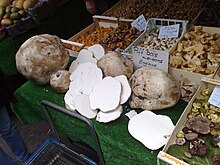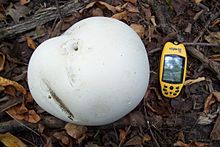|
Calvatia gigantea
Calvatia gigantea, commonly known in English as the giant puffball, is a puffball mushroom commonly found in meadows, fields, and deciduous forests in late summer and autumn. It is found in temperate areas throughout the world.[1] DescriptionAccording to the Missouri Department of Conservation, Calvatia gigantea typically grows up to 20–50 centimetres (8–19+1⁄2 in) wide and high.[2] According to First Nature, it "can grow to 80 cm diameter and weigh several kilograms".[3] A specimen weighing over 23 kg (51 lb) was recorded in Thunder Bay, Ontario, Canada.[4] The interior of an immature puffball is white, while that of a mature specimen is greenish brown.[5][6] The fruiting body of a puffball mushroom develops within a few weeks and soon begins to decompose and rot (at which point it is dangerous to eat). Unlike most mushrooms, all the spores of the giant puffball are created inside the fruiting body; large specimens can easily contain several trillion. The spores are yellowish, smooth, and 3–5 μm in size.[5][6] Similar fungiGiant puffballs resemble the poisonous earthball (Scleroderma citrinum). The latter are distinguished by a much firmer, elastic fruiting body, and having an interior that becomes dark purplish-black with white reticulation early in development. TaxonomyThe classification of this species has been revised in recent years. First Nature explains that "puffballs, earthballs, earthstars, stinkhorns and several other kinds of fungi were once thought to be related and were known as the gasteromycetes or 'stomach' fungi, because the fertile material develops inside spherical or pear-shaped fruitbodies." However, many mycologists now believe that "the gasteromycetes" do not share single ancestor; they are polyphyletic.[7] Today, some authors place the giant puffball and other members of genus Calvatia in order Agaricales. The giant puffball has also been placed in two other genera, Lycoperdon and Langermannia, in years past. The current view is that the giant puffball is Calvatia.[8] Conservation statusThe giant puffball is widespread and common in the United Kingdom. It is protected in parts of Poland and is of conservation concern in Norway.[1] Uses CookingThe large white mushrooms are edible when young,[5][6] as are all true puffballs, but they can cause digestive issues if the spores have begun to form—as indicated by the color of the flesh being yellowish or greenish-brown instead of pure white.[5][6] The Lovesick Lake Native Women's Association explains that an overripe puffball "will fall apart when touched or if cut open" and should be discarded.[9] Immature gilled species still contained within their universal veil can be lookalikes for puffballs. Many such species are poisonous or even deadly. To distinguish puffballs from such poisonous fungi, they must be cut open; edible puffballs will have a solid white interior and have "no gills or other imperfections".[10][11] MedicalPuffballs are a known styptic and have long been used as wound dressing, either in powdered form or as slices 3 cm thick.[12] Authors Hui-Yeng Y. Yap, Mohammad Farhan Ariffeen Rosli, et al. found evidence to suggest that C. gigantea was "traditionally used by American Indians, Nigerian and German folks" for this purpose. The authors, however, did not specify the preferred form of wound dressing (e.g., powdered or sliced). [13] New Zealand Māori used it to stem bleeding and treat burns, it was also a food source.[14] References
Further reading
External links |
||||||||||||||||||||||||||||||||||||||||||||||||




